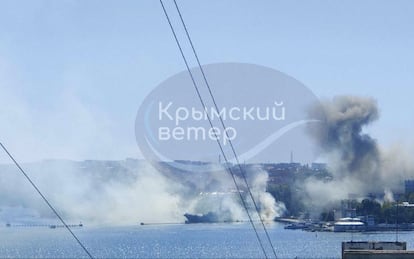Ukraine steps up attacks on Russian Black Sea fleet and targets in Crimea
The Ukrainian Armed Forces have intensified their operations against the invader’s positions in the illegally annexed territory

On Friday, Ukraine hit the Russian navy base in Sevastopol, Crimea, with medium-range missiles. The home port of the Black Sea Fleet is located in the the centre of the city and numerous videos shared on social networks by members of the public have shown several explosions and columns of smoke rising from the Russian fleet’s central headquarters and also from the naval docks. On Saturday, another attack was launched against Sevastopol.
The occupying authorities have indicated that Friday’s bombardment was carried out with missiles and that it only affected the building that serves as the fleet’s headquarters. The images that have emerged from the attack against the Sevastopol captaincy confirm that at least one missile hit the façade, although without causing the building to be destroyed.
In recent weeks, Ukraine has been using a modification of its Neptune marine anti-ship missile to attack ground targets, especially air defense batteries. The Neptune became famous among the Ukrainian population when one of the missiles sank the Moskva, flagship of the Russian fleet in the Black Sea, in 2022.
The latest bombing in Sevastopol comes after Thursday’s attack (again with a Neptune) against the Saky air base, also in Crimea, where 12 combat aircraft were stationed, according to the Ukrainian Security Services (SSU). One of the Russian fleet’s ship dry docks in Sevastopol was also targeted last week by Ukrainian missiles and nautical drones, damaging a submarine and a landing ship. Another blow to the Russian fleet in Crimea came on Wednesday, when long-range Storm Shadow missiles hit the Verkhnosadove base, an underground bunker complex. In addition to the attacks that hit their targets, Ukraine has been mounting daily drone attacks to test the Russian air defense network on the Crimean peninsula, considered one of the best in the world.
The Storm Shadow is a long-range missile produced by the United Kingdom and France, and is the first weapon supplied by NATO allies that the Ukrainian Air Force is using against Russian positions in Crimea. Air Force Commander Mikola Oleshchuk has confirmed that the Storm Shadows have been fired from fighter-bombers.
Until a few months ago, the NATO member states that support Ukraine established as an essential condition that their weapons not be used in attacks on Russian territory, or Crimea. For the Kremlin, Crimea is a red line, an inalienable part of Russian the national identity, and attacking it with Western weapons, as the Russian Ministry of Defense has warned, could cause an escalation in the conflict. Russia annexed Crimea by force in 2014 while supporting separatist uprisings in Donbas, in eastern Ukraine.
The Storm Shadow missiles were used successfully in the attack on the Sevastopol dry dock last week. Ukraine is also using aerial and sea drones to hit Russian warships. Based in Crimea, the enemy fleet is blocking maritime traffic in the Black Sea and preventing Ukrainian ports from accessing the sea. Russia has also occupied the Ukrainian coast of the Azov Sea during the invasion.
The Russian governor of Sevastopol, Mikhail Razvozhayev, reported this Friday that there has also been an “unprecedented” cyber attack that has interrupted internet service on the peninsula.
The secretary of the Security Council of Ukraine, Oleksiy Danilov, has stated on the social network X that the attacks “are precision and exclusively against military infrastructure.” Danilov, in his characteristically provocative tone, wrote that the Russian navy has two options in Crimea, either to sink its ships voluntarily in the face of the enemy’s proximity, or to wait for its fleet “to be sliced like salami.”
Ukrainian pressure on Crimea coincides with the launch of an alternative route to export Ukrainian grain through the Black Sea. Last July, Russia stopped its participation in the so-called “Black Sea Grain Initiative”, by which it had committed to Turkey and the United Nations to allow merchant ships with Ukrainian grain heading to international markets to trickle down from Ukrainian ports. Russia broke the agreement, claiming that Western sanctions hindered its exports. But Ukraine has started a new route this week: without leaving Ukrainian waters, merchant ships sail to ports in neighboring Romania. From there they continue their journey to Turkish waters. Ukraine and shipping companies believe Moscow will not authorize an attack on commercial vessels.
Sign up for our weekly newsletter to get more English-language news coverage from EL PAÍS USA Edition
Tu suscripción se está usando en otro dispositivo
¿Quieres añadir otro usuario a tu suscripción?
Si continúas leyendo en este dispositivo, no se podrá leer en el otro.
FlechaTu suscripción se está usando en otro dispositivo y solo puedes acceder a EL PAÍS desde un dispositivo a la vez.
Si quieres compartir tu cuenta, cambia tu suscripción a la modalidad Premium, así podrás añadir otro usuario. Cada uno accederá con su propia cuenta de email, lo que os permitirá personalizar vuestra experiencia en EL PAÍS.
¿Tienes una suscripción de empresa? Accede aquí para contratar más cuentas.
En el caso de no saber quién está usando tu cuenta, te recomendamos cambiar tu contraseña aquí.
Si decides continuar compartiendo tu cuenta, este mensaje se mostrará en tu dispositivo y en el de la otra persona que está usando tu cuenta de forma indefinida, afectando a tu experiencia de lectura. Puedes consultar aquí los términos y condiciones de la suscripción digital.
More information
Archived In
Últimas noticias
Most viewed
- Reinhard Genzel, Nobel laureate in physics: ‘One-minute videos will never give you the truth’
- Oona Chaplin: ‘I told James Cameron that I was living in a treehouse and starting a permaculture project with a friend’
- Pablo Escobar’s hippos: A serious environmental problem, 40 years on
- Why we lost the habit of sleeping in two segments and how that changed our sense of time
- Chevy Chase, the beloved comedian who was a monster off camera: ‘Not everyone hated him, just the people who’ve worked with him’











































